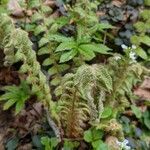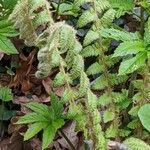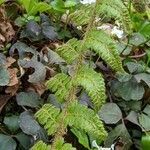Plants summer-green. Rhizome erect or ascending, short, densely covered with scales; scales brown, linear. Fronds 40-70 cm; stipe brown at base, 13-21 cm, 4-5 mm in diam. at base, densely covered with scales; scales brown, linear and lanceolate or larger; large scales dense or somewhat sparse, light brown but below middle often blackish brown, shiny, ovate, ovate-lanceolate, or broadly lanceolate, up to 13 × 6 mm, subentire or slightly toothed, long acuminate or caudate. Lamina bipinnate, oblanceolate, 36-60 × 14-24 cm at middle, gradually contracted toward base, lower part sterile, apex acuminate, fertile; rachis without proliferous bulbils, abaxially with dense light brown linear or lanceolate and larger scales; large scales ovate-lanceolate, up to 4.5 mm wide, subentire, caudate or long acuminate. Pinnae 19-25 pairs, alternate, ascendant, shortly stalked, lanceolate, bases asymmetrical, apices acuminate; middle pinnae 7-15 × 2.3-2.8 cm, 1-pinnate; costa narrowly winged, abaxially with linear light brown scales. Pinnules (2-)6-17 pairs, alternate, sessile, oblong, 0.9-1.7 × 0.5-0.9 cm, bases cuneate, decurrent, acroscopic margins entire, sometimes toothed and even shallowly pinnatifid on large plants, shortly or long aristate, apices acute with acute spine; auricles rounded, small, basiscopic margins aristate; basal acroscopic pinnules largest, incised or pinnatifid; both surfaces densely scaly; microscales brownish, filiform; frond texture thinly papery; venation pinnate, lateral veins 5-7 pairs, dichotomous, distinct. Sori large, (1-)3-6 pairs per pinnule, in 1 row along each side of midrib, close to midrib, terminal or sometimes abaxial on veins; indusia present, entire. 2n = 164.
More
Rhizome erect, lvs 3–9 dm; petiole 13–18 cm, densely scaly; blade lanceolate, 7–17 cm wide, acuminate, reduced below, essentially bipinnate; pinnae 30–40 pairs, acuminate, alternate above, the lower subopposite; pinnules 9–15 pairs on the larger pinnae, ovate-deltoid to ovate-oblong, acute, spinulose-denticulate with incurved teeth, the veins of both surfaces bearing linear scales; sori in one row on each side of the midrib; indusium pale, sublobate; 2n=164. Upland woods and rock ledges in circumneutral soil; circumpolar, s. to Mass., N.Y., Pa., Mich., Wis., and n. Minn. The Amer. plants differ slightly from the Eurasian ones and have been segregated as var. purshii Fernald. A hybrid with no. 1 [Polystichum acrostichoides (Michx.) Schott] is P. ×potteri Barrington.
Stems erect. Leaves monomorphic, arching, 2--10 dm; bulblets absent. Petiole 1/8--1/6 length of leaf, densely scaly; scales light brown, gradually diminishing in size distally. Blade broadly lanceolate, 2-pinnate; base narrowed. Pinnae oblong-lanceolate or falcate, proximal pinnae ± rectangular, not overlapping, in 1 plane, 2--10 cm; base oblique except proximal 3--4 pinnae, where auricles not developed; apex acute, subapical and apical teeth same size; microscales filiform to linear, lacking projections, dense abaxially, sparse adaxially. Pinnules ± stalked, short-falcate to oblique-rhombic, acroscopic auricle well developed on proximal pinnules; margins dentate, with slender bristle tips; apex broadly acute. Indusia ciliate. Spores brown. 2 n = 164.



